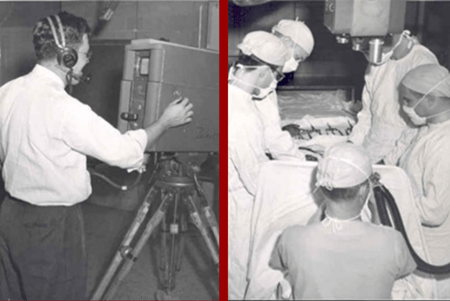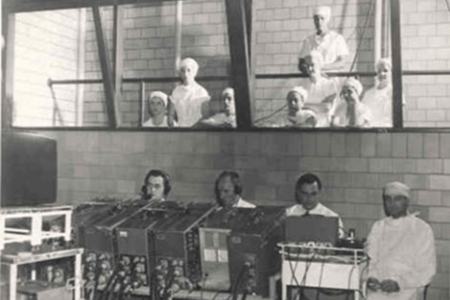The 1949 Centennial Convention of the Indiana State Medical Association (ISMA) was a showstopper that provided a glimpse into the future of medical education. Held in Indianapolis at the Murat Temple from Sept. 26-29, the convention drew a projected audience of 2,200 physicians. About 1,000 attendees participated in venues that demonstrated, for the first time ever, the capabilities and potential for learning from the latest technology – television. Sponsored by Eli Lilly & Company, all television programs were broadcast to the Murat Temple from the Indiana University School of Medicine, where physicians got the opportunity to “see” a variety of clinical programs and surgeries.
The television broadcasts from the Medical Center were received in a Murat Temple meeting room. The television programs included several rare operations performed in Robert W. Long Hospital, the IU School of Medicine’s first teaching hospital. Several 16-inch home-type receivers and one large life-size screen receiver were used for reception of the broadcasts made over a high-frequency closed circuit.
The full three-day scientific session opened with the first of a series of televised surgical operations and medical clinics. A total of 26 clinics were transmitted from the Medical Center to the viewing screens in the Murat Temple during the convention. The television programs proved to be the most popular of all the convention activities and played to capacity audiences.
 John Van Nuys, MD, dean of the IU School of Medicine from 1946-1964, was among those who recognized the new technology of television as a vehicle for teaching and learning. A little over a year later, the ISMA and the IU School of Medicine took a first step together again with the offering of the first postgraduate medical courses transmitted to statewide locations by way of telephone. Among the faculty participating in these pioneering programs were Lyman Meiks, MD, who became chair of the Department of Pediatrics in 1951 (to 1967), and Glenn Irwin, MD, future dean of the IU School of Medicine (1967-1983) and at the time, the newest faculty on board in the Department of Medicine. Others included Harris B. Shumacker, MD; George J. Garceau, MD; Carl Martz, MD; James O. Ritchey, MD; J. Stanley Battersby, MD and John Scott, MD.
John Van Nuys, MD, dean of the IU School of Medicine from 1946-1964, was among those who recognized the new technology of television as a vehicle for teaching and learning. A little over a year later, the ISMA and the IU School of Medicine took a first step together again with the offering of the first postgraduate medical courses transmitted to statewide locations by way of telephone. Among the faculty participating in these pioneering programs were Lyman Meiks, MD, who became chair of the Department of Pediatrics in 1951 (to 1967), and Glenn Irwin, MD, future dean of the IU School of Medicine (1967-1983) and at the time, the newest faculty on board in the Department of Medicine. Others included Harris B. Shumacker, MD; George J. Garceau, MD; Carl Martz, MD; James O. Ritchey, MD; J. Stanley Battersby, MD and John Scott, MD.
The potential for television, the latest technology, was just beginning. The IU School of Medicine and the Indiana State Medical Association led the way into the future with this innovative partnership at the Indiana State Medical Association’s Centennial Convention in 1949.
References:
2,200 Hoosier Doctors to attend Centennial, Indianapolis Star, 9-25-49, p. 1, accessed through Indianapolis Public Library.
Centennial Convention, Journal of the Indiana State Medical Association (December 1949, p. 1264, available at: https://archive.org/details/journalofindiana4211indi/page/1264/mode/2up
Indiana University School of Medicine presents Surgical and Clinical Programs by Television (September 27-September 29, 1949, ISMA Centennial Convention Collection, Indiana State Library.
Authors:
Richard L. Schreiner, MD, Edwin L. Gresham Professor Emeritus of Pediatrics, Indiana University School of Medicine; Retired Chairman, Department of Pediatrics; Retired Physician-in-Chief, Riley Hospital for Children at IU Health; and Chairman, Riley Hospital Historic Preservation Committee;
Karen Bruner Stroup, PhD, Retired Director, Community Education and Child Advocacy, Riley Hospital for Children at IU Health; Secretary, Riley Hospital Historic Preservation Committee
